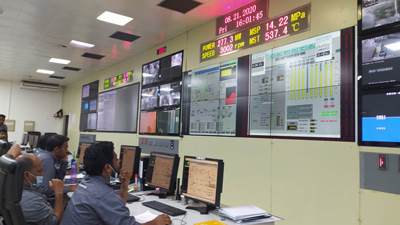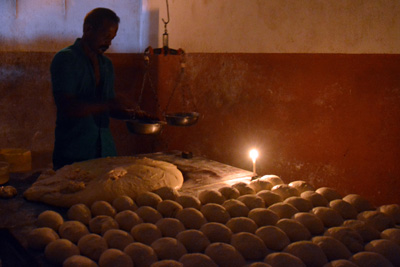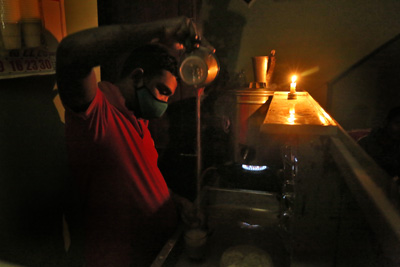News
Shedding light on ‘black’ Monday
The Ceylon Electricity Board’s (CEB) systems control centre (SCC) is a spanking new, Rs 3bn state-of-the art office in Kotte. Its remote terminal units collect data from different points in the grid, allowing for real time data analysis and decision-making. And it monitors 63 grid substations and 15 power plants.

Operation restoration of power: Scene at Norochcholai power plant on Friday. Pic by Hiran Priyankara Jayasekera
On Monday, the room was teeming with engineers. Where there were usually three or four manning a shift, there were now 20 to 30. Some were former systems control engineers. Others were senior professionals systems control experience, including the General Manager. But for several fraught hours, something just kept going wrong. The country was in darkness.
Careless mistake
The crisis broke earlier that day when an electrical superintendent carrying out routine maintenance at the Kerawalapitiya substation “forgot to disconnect the earth from the bus bar before switching the supply back on”.
An electrical bus bar is defined as a conductor or a group of conductors used for collecting electric power from the incoming feeders and distribute them to the outgoing feeders. It is a type of electrical “junction” in which all the incoming and outgoing electrical current meets.
It was a level of careless not expected of “a person of that caliber,” a senior CEB official said. “He has been doing the same thing hundreds of time during the last five years.”
The CEB says that the resultant voltage surge caused the coal power plant at Norochcholai to trip or disconnect from the grid. There was then a “cascade” with other power plants also tripping or leaving the grid as their individual protection systems became automatically activated. This could happen both when demand for electricity is higher than supply or supply is higher than demand.
That was problem enough. But the CEB then failed to reconnect the various power stations to the grid and restore electricity to the country. What should have taken two hours took many more. “We tried every protocol we had in place but it tripped at some point, many times,” said Susantha Perera, Deputy General Manager (Transmission Design).
Black start
At the time, the CEB had to do what is called a “black start”. This means the system was dead, none of the generators were working and the transmission lines were not connected. Following protocols, the engineers started up certain hydro power stations first and started energizing substations step-by-step. 
But each time they tried to connect the load–particularly around Colombo where it was heavy–it tripped. That is, the generators disconnected from the grid.
“We would start up Laxapana, for instance, energize one or two substations and try to connect the load,” Dr Perera said. “When that tripped, we would try the protocol for another generator. It would be successful to a point and then trip. To say it was frustrating was to put it very mildly.”
Why this kept happening is one of the issues various teams, including the CEB’s own internal inquiry, will go into. They will also look into the connection between the issue at Kerawalapitiya and the debacle that followed.
“As to how it happened, I don’t believe anybody knows the answer at the moment,” Dr Perera said. “You have to analyse tons and tons of data to come to a concrete conclusion. But there is nothing to hide and an independent committee is also working on this.”

Small scale busineses were hit badly by the breakdown on Monday. Pix by Lahiru Harshana and Indika Handuwala
“To put it simply, everything in the system is interconnected,” he continued. “When there is something faulty, or a disturbance such as what happened in Kerawalapitiya, there is a sophisticated protection system in place which isolates the healthy system from the faulty part. The basic idea is to protect the generators from the surge that is coming through the system. That is what happened.”
Criticism
But did the protective systems at Norochcholai react too soon? It could have been that they were too sensitive, Dr Perera said, and detected the fault from far away. It was the tripping of the coal power plant–Unit 1 first, followed by the other 2–that caused the cascade, not the Kerawalapitiya fault.
Critics like Vidhura Ralapanawe, who closely analyses developments in the power sector, question how the whole system went under so fast. The Kerawalapitiya grid substation accounted for only six percent of the load in the system, he said. The normal rule of thumb is that up to 10 percent of sudden loss can be tolerated in the grid system.
“In a properly coordinated grid system, where the protection co-ordination is done accurately, the protection system works only to get the faulty area isolated by leaving the other healthy areas in operation,” Dr Ralapanawe pointed out. “The whole idea of having protection systems working at different levels is to isolate the unhealthy part of the system in order to protect the healthy part getting affected.”
“For an example, if you have a fault in your bedroom air-conditioner, then only the circuit breaker supplying power to your bed room area should trip,” he said. Not the whole house. And, of course, that fault should not trip the transformer feeder supplying your housing area.”
Electrical superintendent
Dr Ralapanawe also questioned how the electrical superintendent attended to the maintenance work at Kerawalapitiya without the supervision of an engineer.
“It may be true that the physical work of earthing has been done by an electrical superintendent but this activity involves a very high-level, knowledgeable skilled engineer to authorize the work and also to carry out the work,” he said. “If so, who is CEB trying to defend by putting the superintendent in front?”
He asked whether CEB had standard operating procedure for such maintenance work and which CEB officer must approve the work. Had this procedure been followed and required clearance obtained? And is approval needed from the SCC?
“It is strange and not acceptable at all if this kind of protection and interlock bypass has not been done under the supervision of a senior protection engineer of the CEB,” he insisted.
“You can argue either way, whether there should have been a supervisor or not,” Dr Perera replied. “Fact is he has been doing this work and followed the required permit process each time. An electrical superintendent in the CEB is a highly technical person with almost the same training as engineers.”
Power cuts
With Norochcholai off the grid, the CEB introduced rolling power cuts that ended on Friday when Unit 1 was reconnected to the grid. Unit 2 and 3 were expected to follow after they cooled down enough to be restarted.

